The Wheelchair Guide
Your Wheelchair and Mobility Scooter Resource
Saving Money on Mobility Scooter Accessories
Monday, November 30th, 2009
Mobility scooters are one of the most popular mobility vehicles used by seniors. They offer the convenience of an electric wheelchair, but usually cost less. This makes them an excellent choice for those who are able to walk for short periods of time, but with difficulty.
What Are Mobility Scooters?
The mobility scooter shares a number of similarities with electric wheelchairs, but the design is actually quite different. In an adult scooter, a chair sits towards the back of a base that is quite longer than most electric wheelchairs. A set of handlebars, called a tiller, extends from the front of the scooter, which allows the user to control the direction and speed of the electric scooter.
It is possible to get a three wheel or four wheel mobility scooter, with four wheel mobility scooters offering better stability and weight support. Three wheeled scooters, however, have better maneuverability and usually weigh less than 4 wheel scooters. For those who are going to be using the scooter primarily indoors, 3 wheeled scooters are often a good choice, as they work well in smaller spaces. For outdoor use or if a higher weight capacity is needed, 4 wheeled scooters are almost always the best choice.
Choosing the Right Mobility Scooter Accessory
There are actually a number of different mobility scooter accessories available, which can make the mobility vehicle more comfortable or more convenient. When considering accessories, it is important to differentiate between accessories that are specific to the actual model of scooter and generic accessories.
Scooter specific accessories, which are designed to only work with a specific brand or model of scooter, can be more expensive and are not carried by as many dealers. Some examples of scooter specific accessories would be an automatic lifting seat, which electronically raises and lowers the scooters seat, making transfers more convenient.
Generic Scooter Accessories, on the other hand, are often available much cheaper if you do a little shopping around and since they will work with many types of mobility scooters, it is not necessary to buy them from the same place you buy your scooter. Instead, it is often possible to save a great deal of money by doing some shopping around, where this is not really the case, with the price of most scooters being set by the manufacture.
For example, many mobility scooter dealers will sell visibility flags that can be attached to a scooter, making it more visible in crowds or to vehicles. A visibility flag would be considered a generic accessory, because it is not designed for a specific scooter and will instead work with most models. However, you can often get a much better deal if you goto your local bike shop and buy one of their flags. Scooter bags are much the same and you really can save a great deal of money by shopping around.
There are many types of scooter accessories, including oxygen holders, cane holders, bags, scooter trays, and baskets. By understanding the difference between scooter specific accessories and generic scooter accessories, you can save a great deal of money, because most dealers have a high markup on their accessories. These are the bread and butter, especially if you are getting your scooter for below MSRP.
Frugal TIP: Goto your local bike shop or sports store when looking for things like side-view mirrors, visibility flags, and bags for your scooter. Often, you will save money on these types of generic scooter accessories, as well as getting it right away instead of having to pay and wait for shipping.
A Look at Mobility Scooters and Their Uses
Monday, September 14th, 2009
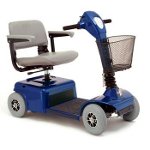 The mobility scooter has actually been around for almost fifty years, but it did not gain popularity until the end of the twentieth century. This was in part because the cost of mobility scooters was much greater until that point. Perhaps the Rascal Mobility Scooter is the most well known, which helped bring these devices to the publics conscious, but today, mobility scooters are more popular than ever.
The mobility scooter has actually been around for almost fifty years, but it did not gain popularity until the end of the twentieth century. This was in part because the cost of mobility scooters was much greater until that point. Perhaps the Rascal Mobility Scooter is the most well known, which helped bring these devices to the publics conscious, but today, mobility scooters are more popular than ever.
Mobility Scooter Design and Their Differences from Electric Wheelchairs
Mobility scooters are in many ways similar to electric wheelchairs, with many of the popular mobility scooter manufacturers, such as Pride Mobility Scooters and Golden Mobility Scooters, offering both types of devices. As a result, they share many of the same components and electrical systems, but the actual layout of a mobility scooter is much different from an electric wheelchair. It is this difference in design, which makes the purposes of electric wheelchairs and electric scooters much different.
The basic difference is that a mobility scooter has a much longer base, often more than 5 times as long as an electric wheelchair. The user is positioned towards the rear of the electric scooters base and a tiller, which is basically a set of handlebars, is installed on the front of the scooter. As a result of the longer base and the tiller, a mobility scooter is not something you could drive up directly to a table or desk as you would an electric wheelchair. Instead, it would be necessary to transfer to a chair or drive the scooter up parallel to the table, although the latter will often not allow the user to make full use of the table.
With the difference in design between electric wheelchairs and electric scooters comes a difference in target markets. Most of those who use mobility scooters are able to walk for short distances, but have difficulty walking for extended periods. This makes them very popular among seniors, who might not otherwise be able to fully use their home, go shopping, or spend time with their family. Some people who use wheelchairs, however, do enjoy using mobility scooters for outdoor use though, especially heavy duty mobility scooters, which can be driven pretty much anywhere.
With the similar functions of electric wheelchairs and mobility scooters, it begs the question, why don’t people just use electric wheelchairs. There are several answers to this, but cost is often a leading factor, as most mobility scooters cost considerably less than the average electric wheelchair. Mobility scooters are also often better suited for longer distances and rougher terrains.
Mobility Scooter Manufacturers
There are many electric scooter manufacturers, but those manufactured by Pride Mobility and Golden Technologies are the most common, with both of these companies having been involved in the mobility vehicle industry since the early nineties. There are a number of lesser manufacturers as well, but the quality of Pride Mobility Scooters and Golden Mobility Scooters is well known and respected. These companies both also offer comprehensive warranties on their scooters.
ShopRider is another popular company, although they lean more towards the budget end of the spectrum and are often not as durable as Pride Scooters and Golden Scooters. Drive Medical is another mobility scooter manufacturer, who is most well known for their manual wheelchairs, although they also offer a number of other medical devices.
There are also a number of no-name mobility scooters available, often from manufacturers in China. These usually cost a great deal less, but are not made to the same high standards as the well known mobility scooter manufactures, are prone to failure, and are usually not covered by a very comprehensive warranty.
Mobility Scooters: The Accessibility Accelerator
Monday, September 7th, 2009
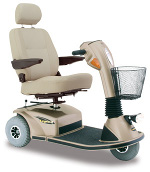 One of the most common types of mobility vehicles used by seniors to improve accessibility and make it easier to get around is the electric scooter. These devices have been around for over fifty years, but they did not become popular until the 1980′s, when the price of electric scooters was decreased.
One of the most common types of mobility vehicles used by seniors to improve accessibility and make it easier to get around is the electric scooter. These devices have been around for over fifty years, but they did not become popular until the 1980′s, when the price of electric scooters was decreased.
Basic Mobility Scooter Design
Electric scooters, which are most often referred to as mobility scooters or adult scooters, are intended to be used by those who have difficulty walking for extended distances. The user sits in a chair that is mounted to the base of the mobility scooter, controlling it by a set of handlebars, called the tiller, that extend from the front of the device.
Using the tiller, which can be adjusted to accommodate people with different arm spans and of differing size, the senior can control the direction of the mobility scooter, its speed, and any other components the scooter may have, such as its headlights.
The tiller extends from the front of the mobility scooter, while the chair is positioned more towards the rear. As a result of this design, it is not possible to drive a mobility scooter directly up to a table in the same way you could a wheelchair. Instead, it is necessary either transfer to an actual chair or parallel park the mobility scooter next to the table.
This is the major difference between mobility scooters and electric wheelchairs, making mobility scooters more practical for those who are able to walk on their own. However, there are some wheelchair users who like to use mobility scooters for outdoor use, but do not rely on them for their daily activities. Among wheelchair users, the heavy duty mobility scooter is most popular, as it is designed to be driven over almost any type of ground, has a much larger per-charge traveling distance and top speed than most wheelchairs.
Rechargeable Batteries and Range
Like electric wheelchairs, mobility scooters use a rechargeable battery system for power. Depending on the model and type of mobility scooter, the range of these devices can greatly vary. Typically lower end mobility scooters have a range of less than 5 miles per charge. Higher end scooters have a much larger range, usually between 10 and 20 miles per charge, with some heavy duty scooters exceeding 40 miles in a single charge.
Usually the price difference between a low end model and one that has a better per charge range is not very large, especially when you consider the difference in quality.
Advantages of Battery Packs
Some mobility scooters use a battery pack system, which allows the battery to be removed easily by simply pushing a release button. Others use a battery system more similar to an automobile, which has wires that must be removed in order to replace the battery.
One of the main advantages of a mobility scooter with a battery pack is that users can purchase an extra battery pack for the scooter. When one battery pack runs down, they can then quickly switch it out and be ready to go again, leaving the other battery pack to charge. This is popular amongst those who do a great deal of traveling with their scooter or consistently drive further than its single battery range.
Mobility Scooters: Three Wheel or Four Wheel?
Friday, September 4th, 2009
Mobility scooters are one of the most common types of mobility vehicles. These devices have been around for over 50 years and there are many different types and models available.
In many ways, mobility scooters are very similar to electric wheelchairs, however, these types of mobility vehicles are designed for different purposes.
Mobility scooters are typically designed as supplements for those who have difficulty walking. However, due to the way they are set up, you can not drive a mobility scooter directly up to a table. Instead, it is usually necessary to transfer to a chair.
Electric wheelchairs, on the other hand, are designed for those who are not able to walk at all, so you would be able to drive an electric wheelchair directly up to a table or desk.
There are many different mobility scooter manufacturers and countless models, so choosing the right electric scooter can seem difficult, but it does not need to be. By learning about the different types of mobility scooters offered, you can narrow down the options and select the one that will best fit your needs.
One way that mobility scooters are classified is by the number of wheels the devices have. Mobility scooters can be classified as three wheel scooters or four wheel scooters, with both offering their own advantages and disadvantages.
Three Wheel Scooters
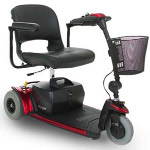 Three wheeled mobility scooters are popular because they have a very small turning radius. They have two rear wheels and one front wheel, which makes them very maneuverable. This makes three wheel scooters an excellent choice for primarily indoor use or in areas that might have tight quarters.
Three wheeled mobility scooters are popular because they have a very small turning radius. They have two rear wheels and one front wheel, which makes them very maneuverable. This makes three wheel scooters an excellent choice for primarily indoor use or in areas that might have tight quarters.
Three wheeled scooters also typically weigh a little less. Travel scooters, which are designed to be taken apart easily for transport, often use a three wheel design to help reduce weight.
Four Wheeled Mobility Scooters
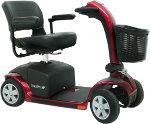 Four wheeled mobility scooters are not quite as maneuverable, but they do offer improved stability. This is because the weight is more evenly distributed across four wheels, the scooter. As a result, four wheeled scooters are a better choice for those who wish to use the device outdoors or need a scooter with a higher weight capacity.
Four wheeled mobility scooters are not quite as maneuverable, but they do offer improved stability. This is because the weight is more evenly distributed across four wheels, the scooter. As a result, four wheeled scooters are a better choice for those who wish to use the device outdoors or need a scooter with a higher weight capacity.
Heavy duty scooters, which are designed for increased weight support and to be driven over virtually any terrain, almost always make use of a four wheel design, as this is a much stabler for off road use.
Putting it all Together and Selecting the Right Mobility Scooter
Since mobility scooters are used to help make getting around easier, it is important to select the right type of mobility scooter. It is a good idea to spend some time thinking about where you will be using the scooter, as well as the physical attributes of the rider.
First, plan out where you would like to be able to drive your mobility scooter, such as around the neighborhood or the grocery store. Then, evaluate the type of terrain you would be driving over. This, along with the size and general abilities of the driver, will help you narrow down your options and selecting the right mobility scooter.
Mobility Scooters Explained
Monday, August 17th, 2009
For the elderly, it is common for diseases like arthritis to make it very difficult to walk for extended periods of time. This can have a very big impact on the seniors life, as they are no longer able to spend as much time with family or even walking around a store. Many seniors will use rolling walkers, which are called rollators, or canes, but even when using this type of mobility aid, it still requires a great deal of effort to walk. For more extended use, a mobility scooter often provides a much more practical walking aid for seniors.
Mobility Scooter Basics
Mobility scooters are similar in function to electric wheelchairs, but they are designed quite differently and usually cost a good deal less as well. For example, typically a low end power chair costs as much as a high end mobility scooter, so for seniors who have difficulty walking, a mobility scooter is often the best choice.
The mobility scooter provides a platform with three or four wheels, upon which a chair is placed. The chair is positioned more towards the back of the electric scooter and a set of handlebars extends from the front. The handlebars, called a tiller, not only controls the mobility scooter, but also usually operates its running lights, contains a throttle to control speed, and a battery charge indicator. It is also not uncommon to place a basket on the tiller to hold groceries or other goods.
Three Wheel Scooters vs Four Wheel Scooters
The number of wheels that the scooter has, three or four, is an important consideration, as this relates to both maneuverability and stability. A three wheeled scooter will have better maneuverability at the cost of stability. A four wheel scooter, on the other hand, has better stability as the weight of the user is more evenly distributed. However, this improved stability comes at the cost of a decrease in maneuverability.
As a result, a three wheel scooter is a great choice for indoors and occupants with lower weights. For a higher weight capacity adult scooter or one that will be used a great deal outdoors, it is better to go with a four wheel scooter.
The Three Basic Types of Mobility Scooters
There are three basic types of mobility scooters, travel scooters, heavy duty scooters, and standard scooters.
Travel scooters are designed to be lightweight and taken apart easily. The individual pieces typically do not weigh more than thirty pounds and so it is not necessary to use a vehicle scooter carrier to transport a travel scooter. They are also easily transported on planes.
To reduce weight, most extra features are cut, including lighting systems, lower weight capacity, the type of seat used, and extra body panels to protect against low impact collisions, such as running into the leg of a table. Most travel scooters are also usually three wheel scooters, as this is also lighter. They also have a significantly lower per charge range and top speed.
Heavy Duty Scooters are almost the exact opposite of a travel scooter and are designed for off road use. They have a very high weight capacity and many extra features. This includes larger tires, improved suspension, upgraded body panels, reinforced bumpers, complete lighting systems, higher ground clearance, and an upgraded captain’s chair. Heavy duty scooters also have a very large per charge range and top speed.
Of course, due to the size of a heavy duty scooter, it is almost always necessary to invest in a vehicle scooter carrier to transport the device and they are not always as well suited for the tight quarters of a living room.
Standard scooters form the middle ground, offering improved functionality, features, range, and speed when compared to travel scooters, but less so when compared to heavy duty scooters. Typically, transporting a standard scooter also requires a vehicle scooter carrier.
Senior Accessibility Tools: Walkers, Wheelchairs and Mobility Scooters
Friday, August 7th, 2009
It is often very difficult for seniors to get around and walk for an extended period of time. This restriction can ultimately has a very big impact on their day to day life, as it is necessary to avoid many of the things they enjoy, such as going to the park with the family or walking around the neighborhood. There are three main devices used to address this issue, namely the walker, the mobility scooter, and the wheelchair.
A Brief Look at Walkers
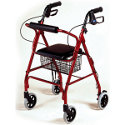 Walkers have been popular for many years now and come in a number of different styles. Typically, walkers provide system that makes contact with the floor at four different points, to provide increased stability as compared to a cane. Hand holds are provided for both arms and the senior is able to move forward, leaning against the walker for support.
Walkers have been popular for many years now and come in a number of different styles. Typically, walkers provide system that makes contact with the floor at four different points, to provide increased stability as compared to a cane. Hand holds are provided for both arms and the senior is able to move forward, leaning against the walker for support.
Over the past few years, rollators, which are essentially rolling walkers, have become much more popular. Many seniors find rollators much easier to use, because instead of having to lift the walker up with every few steps, they can simply roll it forward. Most rollators also double as a seat and provide a storage basket. There are also hand brakes on the hand holds, which can be locked in place when the senior is not moving.
A Brief Look at Mobility Scooters
 Mobility Scooters are very popular among seniors and provide a motorized way to get around. They have an elongated flat base, with 3 or 4 wheels, and are controlled by a set of handlebars, called a tiller, that extends from the front of the electric scooter. A chair is positioned towards the rear of the mobility scooter.
Mobility Scooters are very popular among seniors and provide a motorized way to get around. They have an elongated flat base, with 3 or 4 wheels, and are controlled by a set of handlebars, called a tiller, that extends from the front of the electric scooter. A chair is positioned towards the rear of the mobility scooter.
Most mobility scooters have a pretty significant range, with some traveling over 15 miles on a single battery charge. Using one allows the senior to get around with ease, traveling over pretty much any type of terrain. However, some are only designed for tightly packed ground.
Electric mobility scooters are powerful aids, used by many seniors and others who have difficulty walking. They can be used both indoors and outdoors, providing an easy and fun way to increase accessibility.
A Brief Look at Wheelchairs
 Wheelchairs are also a popular tool used by seniors who have difficulty walking, however since a wheelchair requires a lot of physical effort to use, they can not always be used independently. Instead, it is usually necessary to rely on someone to push the wheelchair from behind.
Wheelchairs are also a popular tool used by seniors who have difficulty walking, however since a wheelchair requires a lot of physical effort to use, they can not always be used independently. Instead, it is usually necessary to rely on someone to push the wheelchair from behind.
Electric wheelchairs are available as well, but are usually considerably more expensive than mobility scooters. However, unlike mobility scooters, an electric wheelchair can be driven directly up to a table or desk, without having to switch to a chair. So, many people find electric wheelchairs more convenient than mobility scooters.
The Different Types of Mobility Scooters
Monday, July 20th, 2009
For seniors and others who have difficulty walking around, the mobility scooter has been a powerful asset for some time. The first mobility scooters where developed about fifty years ago, but they really did not become practical or popular until the 1980′s.
Today, there are a number of different kinds of mobility scooters available, but they can basically be broken down into three distinct categories: Travel Scooters, Heavy Duty Scooters, and Traditional Scooters. Knowing the difference between these types of mobility scooters is very important, because they each offer their own advantages and disadvantages.
Travel Scooters
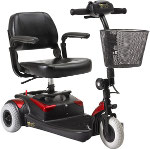 Travel scooters are very popular, because they are lightweight and can be easily disassembled into several easy to manage pieces. Usually, the heaviest piece will weigh less than 30 pounds, so they can be easily picked up and placed in the trunk of a car, stored on a plane, or even placed into the backseat of a vehicle. Many travel scooter are also very easy to take apart and feature clasps that can be operated while only using a single hand. Since these types of scooters can be so easily transported, they can make them a great tool for going to an amusement park or visiting a new city.
Travel scooters are very popular, because they are lightweight and can be easily disassembled into several easy to manage pieces. Usually, the heaviest piece will weigh less than 30 pounds, so they can be easily picked up and placed in the trunk of a car, stored on a plane, or even placed into the backseat of a vehicle. Many travel scooter are also very easy to take apart and feature clasps that can be operated while only using a single hand. Since these types of scooters can be so easily transported, they can make them a great tool for going to an amusement park or visiting a new city.
While travel scooters can be very easy to transport, their lightweight comes at the cost of reduced functionality and stability. They are often not able to support as much weight, nor will a travel scooter fair as well over rougher terrain. Also, travel scooters are basically stripped of all extra features, to help reduce weight, including having a reduced per-charge range.
Travel Scooters Typically Cost: $800 – $1500
Heavy Duty Scooters
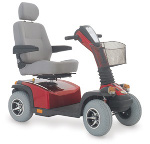 Heavy Duty Scooters are pretty much the exact opposite of travel scooters. A heavy duty scooter offers superior weight capacity and off road maneuverability. They feature reinforced frames and often include special bumpers for added protection. Larger off-road tires and improved ground clearance make heavy duty scooters able to be driven pretty much anywhere. These mobility vehicles also include a number of other features designed to improve comfort and usability, such as overstuffed captains chairs and upgraded suspension.
Heavy Duty Scooters are pretty much the exact opposite of travel scooters. A heavy duty scooter offers superior weight capacity and off road maneuverability. They feature reinforced frames and often include special bumpers for added protection. Larger off-road tires and improved ground clearance make heavy duty scooters able to be driven pretty much anywhere. These mobility vehicles also include a number of other features designed to improve comfort and usability, such as overstuffed captains chairs and upgraded suspension.
While heavy duty scooters are an excellent tool for those who need a higher weight capacity or want a scooter that can be driven off-road with confidence, they are fairly large in size. They also have a larger turning radius, so when combined with their large size, heavy duty mobility scooters might take up too much space to be used effectively inside of a home. Also, due to their size, a vehicle scooter carrier is required to transport them. Like other types of mobility scooters, a heavy duty scooter can be disassembled, however the individual pieces are much heavier, sometimes weighing over 100 pounds. It is also not as easy to disassemble as a travel scooter would be.
Heavy Duty Scooters Usually Cost: $1500 – $5000
Traditional Scooters
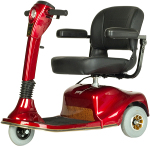 Traditional scooters fall in between heavy duty scooters and travel scooters. They preform well inside of a home and can also be used over most outdoor surfaces, providing the surface is fairly well packed. They include a number of features, such as running lights, and typically have a per-charge range of around 8 – 10 miles. Traditional scooters provide a great deal more stability than a travel scooter and typically support more weight as well.
Traditional scooters fall in between heavy duty scooters and travel scooters. They preform well inside of a home and can also be used over most outdoor surfaces, providing the surface is fairly well packed. They include a number of features, such as running lights, and typically have a per-charge range of around 8 – 10 miles. Traditional scooters provide a great deal more stability than a travel scooter and typically support more weight as well.
While traditional scooters are very sturdy, they are not as well suited for rougher outdoor terrain or wet ground. These types of scooters can be taken apart as well, but the individual pieces are not as lightweight as a travel scooter, nor is a traditional scooter as easy to take apart. In most cases, a vehicle scooter carrier is required to transport these devices, as they take up much more space and are a good deal heavier than travel scooters.
Traditional Scooters Typically Cost: $1300 – $2500
Increasing Accessibility With a Mobility Scooter
Wednesday, June 10th, 2009
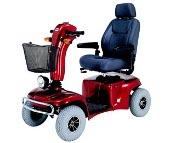 Often, for seniors walking for an extended period of time can become very difficult. Many times, this is not a big issue when at home, but it can make going anywhere, even to the grocery store, very difficult. To make it easier to get around, the mobility scooter is one of the more popular mobility vehicles available for a senior.
Often, for seniors walking for an extended period of time can become very difficult. Many times, this is not a big issue when at home, but it can make going anywhere, even to the grocery store, very difficult. To make it easier to get around, the mobility scooter is one of the more popular mobility vehicles available for a senior.
While wheelchairs have been used for thousands of years, the mobility scooter is fairly new, dating back only about fifty years. Mobility scooters also use a design that is very different from that of a wheelchair. One of the major differences is that due to the way a scooter is designed, you can not drive it directly up to a table or desk, so will likely have to transfer to a regular chair when eating or working.
Typically, the mobility scooter will have a rectangle shaped base, with wheels at the front and back. A chair is mounted slightly off center, positioned more towards the back of the base. Depending on the chair, it could offer a very simple lightweight design, or it could be a luxurious captains chair, with a reclining back.
A set of handlebars, called the tiller, extends from the front of the base and can be moved closer to the chair as needed. The tiller is used to control the direction and acceleration of the mobility scooter. A headlight, turn signal, and basket are also often attached to the tiller. They also typically have keyed entry, to protect the scooter from unauthorized use.
Mobility scooters are very popular, because they allow an individual to move easily over relatively large distances, with little physical effort. The range varies by model, but most adult scooters can travel at least five miles on a signal charge, with some capable of traveling more than 30 miles without requiring a charge. It is usually possible to purchase an extra battery pack for the scooter, which effectively doubles the range of the device. When one battery wears down, the battery can be taken out and charged, with the other battery pack being added. Most people will not require an extra battery pack, but it might be a good idea for those who are always on the go and don’t want to be stuck waiting for their mobility scooter to recharge.
Since the mobility scooter is battery powered, it can safely be used indoors or outdoors, although some are better suited at outdoor use than others. Typically, four wheel scooters provide a more stable platform for outdoor use and three wheeled scooters have a smaller turning radius, so are better for indoor use. Most will preform equally well over tightly packed terrain though, so for many people the extra stability offered by a four wheeled adult scooter is negligible.
For the mobility challenged senior, an electric mobility scooter is a very valuable tool that helps increase their mobility. These devices are available to accommodate people of all sizes and can be a valuable asset for those who have problems walking for extended periods of time.
Mobility Scooters for Seniors
Friday, May 22nd, 2009
 One of the most popular, if not the most popular, mobility aids for seniors is the mobility scooter. Mobility scooters were first developed during the 1960′s and share many similarities with the electric wheelchair.
One of the most popular, if not the most popular, mobility aids for seniors is the mobility scooter. Mobility scooters were first developed during the 1960′s and share many similarities with the electric wheelchair.
An electric motor propels the mobility scooter and it uses one or more batteries, much like a power chair. Often they also share a similar, if not identical captains chair, which includes the same types of features, such as a reclining back, electric lifting system, and swivel controls to make exiting the mobility vehicle much easier.
Like the other two kinds of mobility vehicles, mobility scooters also feature anti-tip casters to prevent the device from tipping over backwards.
However, the physical design of a mobility scooter is actually much different than that of a wheelchair, both electric and manual. This is because they have a much longer wheel base and the captains chair is mounted on the rear of the base.
Mobility Scooter Control Systems
Instead of an armrest mounted joystick, like is used on an electric wheelchair, a mobility scooter is controlled by a set of handlebars, which extends from the front of the scooters base. These handlebars, which are referred to as the tiller, can be adjusted to accommodate riders of different sizes. This allows the mobility scooter’s tiller to be brought closer or moved farther from the captains chair.
Depending on the model of scooter, the tiller might have a headlight, turning signals, battery meters, keyed entry, and troubleshooting gauges on it. Due to the location of the tiller, a mobility scooter can not be driven directly up to a table or desk.
Three Wheeled and Four Wheeled Mobility Scooters
There are a number of different types of mobility scooters available, with many different models available. There are also several ways that an electric mobility scooter can be classified.
One of the most common ways to classify a mobility scooter is by the number of wheels it has. 4 wheeled mobility scooters have two wheels in front and two wheels in the rear. This provides more stability, because as in the case of a rear wheel drive power chair, the weight of the occupant is spread out more evenly. This makes a 4 wheeled scooter more stable than a 3 wheeled scooter.
While a three wheeled mobility scooter might not be as stable as a four wheeled scooter, they are typically much more manuverable and have a turning radius that is considerably smaller than that of a four wheeled scooter. This makes a 3 wheeled scooter preferrable for indoor use. They are also typically lighter in weight.
Different Mobility Scooters for Different Uses
The other way that mobility scooters are classified is by their intended use. For example, there are travel scooters, heavy duty scooters, and traditional scooters.
 Travel scooters are designed to be as light weight as possible, so they can be taken on vacation or away from the home. They are also designed so that they can be easily disassembled, with all of the pieces being a manageable weight. Often the heaviest piece weighs less than 30 pounds, so most people are able to disassemble it and place it in the trunk of their car or rear seat of their vehicle.
Travel scooters are designed to be as light weight as possible, so they can be taken on vacation or away from the home. They are also designed so that they can be easily disassembled, with all of the pieces being a manageable weight. Often the heaviest piece weighs less than 30 pounds, so most people are able to disassemble it and place it in the trunk of their car or rear seat of their vehicle.
Most travel scooters are three wheeled, as this helps reduce the overall weight of the electric scooter. They also have fewer features, like a scaled back captains chair and no running lights, to further save weight.
Travel scooters do not have the same weight support or range that you could expect from other scooters, but for vacation they can be a great choice.
 On the opposite side of the spectrum you have heavy duty scooters. A heavy duty mobility scooter is designed to be as rugged and durable as possible. They have the highest weight support, usually feature reinforced bumpers, larger tires, and are packed with features. They are designed, as the name implies, to be used over rough outdoor terrain. Typically, most are four wheeled as this provides the most stability, but there are a few three wheeled heavy duty scooters.
On the opposite side of the spectrum you have heavy duty scooters. A heavy duty mobility scooter is designed to be as rugged and durable as possible. They have the highest weight support, usually feature reinforced bumpers, larger tires, and are packed with features. They are designed, as the name implies, to be used over rough outdoor terrain. Typically, most are four wheeled as this provides the most stability, but there are a few three wheeled heavy duty scooters.
Heavy duty scooters also usually have a very high top speed, large per charge range, and can be a great deal of fun to drive.
While great for outdoor use, since a heavy duty scooter is typically much larger than other electric scooters, it can not be used in some indoor situations and has a much larger turning radius. It also weighs a great deal more so taking it apart and placing it in a vehicle might not be an option for most people. Heavy duty electric scooters are also the most expensive type of mobility scooter.
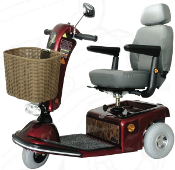 All other mobility scooters fall into the category of traditional scooter. These come in a variety of sizes and while they have many more features than a travel scooter, they have fewer than a heavy duty scooter. Typically though, they will have things like running lights. They come in either 3 wheeled or 4 wheeled designs.
All other mobility scooters fall into the category of traditional scooter. These come in a variety of sizes and while they have many more features than a travel scooter, they have fewer than a heavy duty scooter. Typically though, they will have things like running lights. They come in either 3 wheeled or 4 wheeled designs.
When compared to travel scooters, traditional scooters offer increased weight support, range, top speed, stability, and durability. Like heavy duty scooters, the weight of a traditional scooter often makes disassembling it not an option, because the lightest piece can often weigh well over 70 pounds.
Seniors and Mobility Scooters
Price wise the cost of a mobility scooter usually falls in the middle, between a manual wheelchair and electric wheelchair. They are easy to use and have a greet range, so can be a good choice for a senior who has difficulty walking.
Due to the location of the tiller, you are not able to drive a mobility scooter directly up to a table, which means that some mobility is required of the user in order to get the most benefit out of a mobility scooter.
For someone who can walk, but not for extended periods of time, a mobility scooter would be a good choice. However, for someone who can not walk, a mobility scooter might not be a good choice.